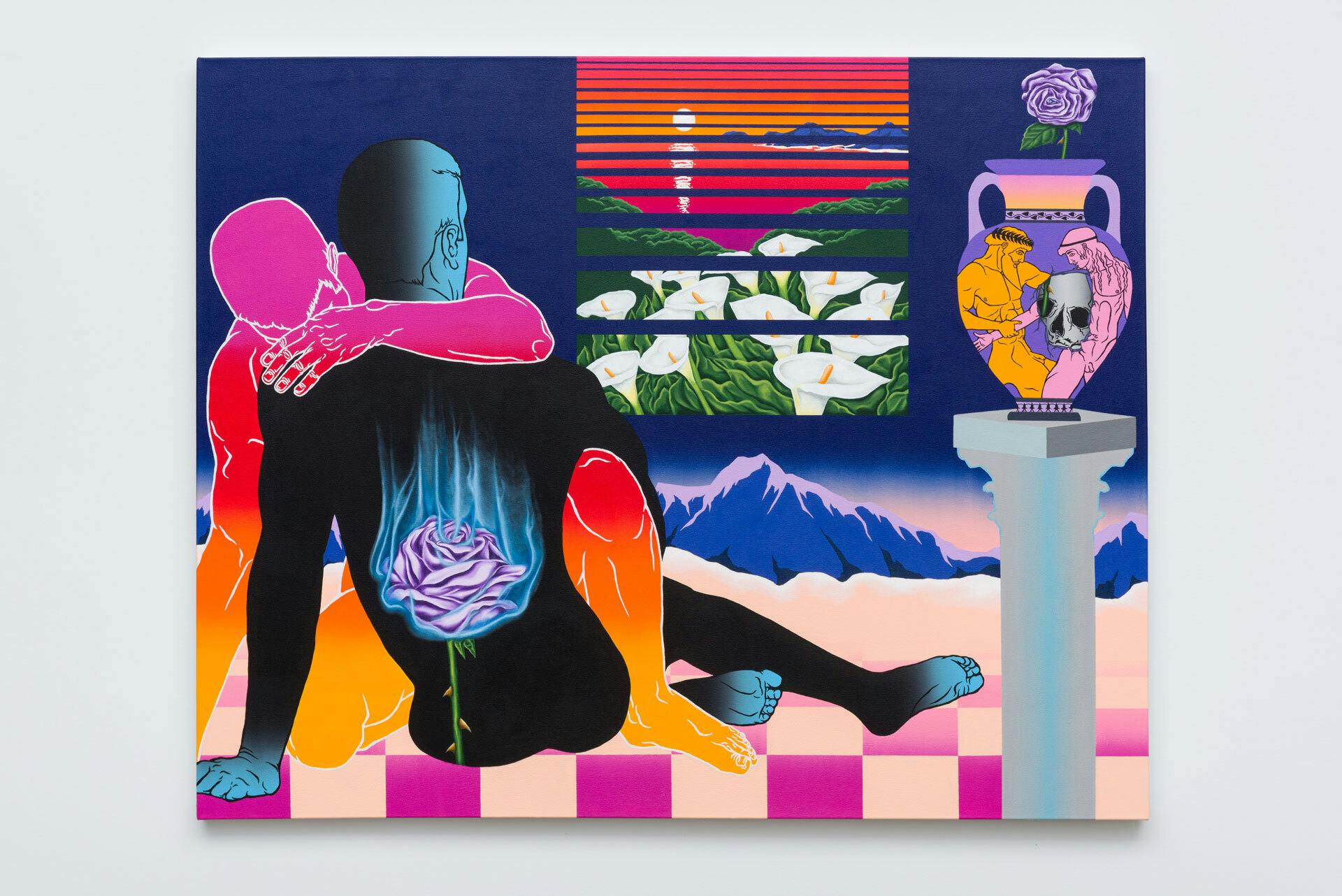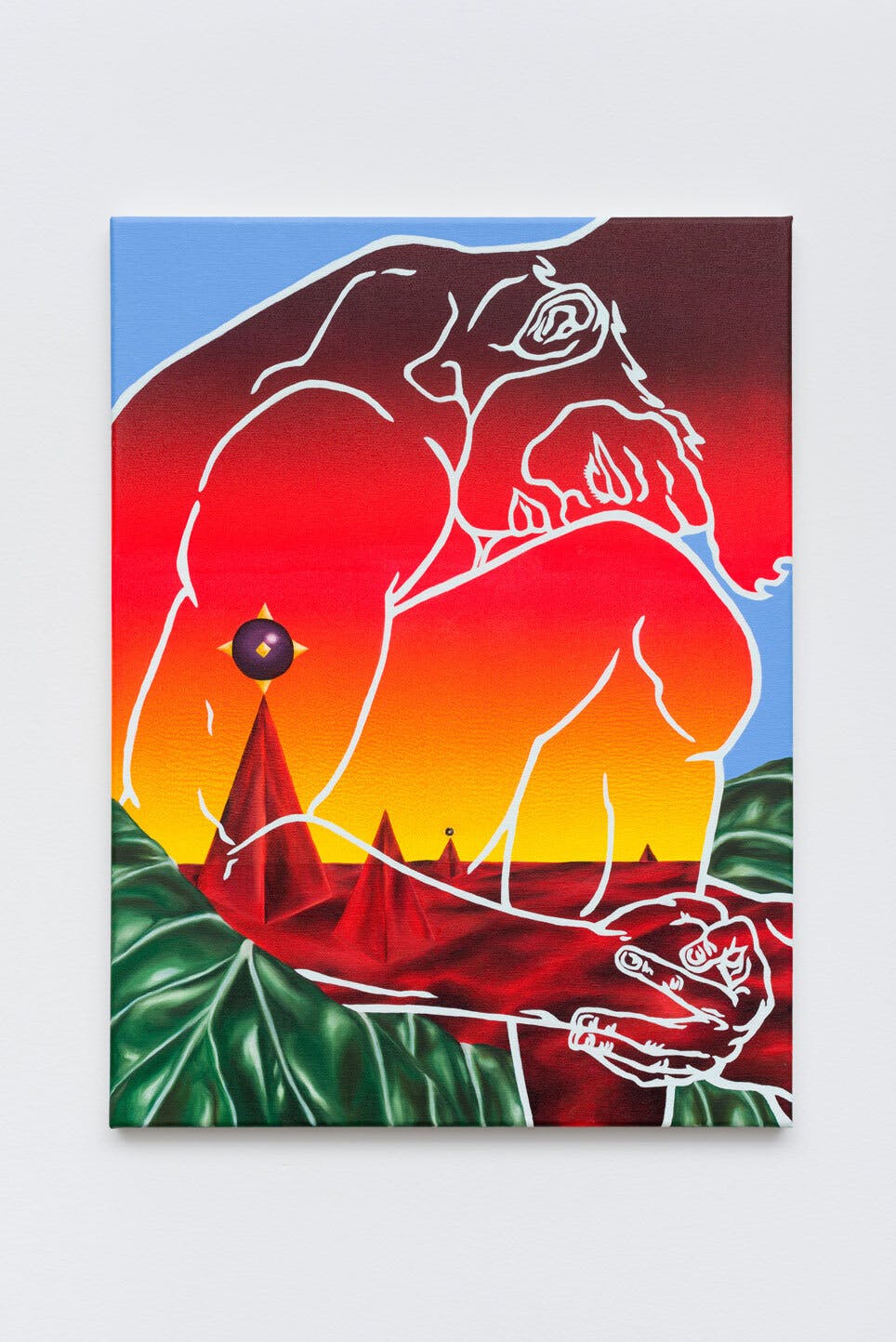Published July 29, 2022
Manipulating Hyper Masculine Images: Paul Anagnostopoulos’s Studio Spotlight
Exploring mythological desire, longing, and tragedy, Paul Anagnostopoulos’s paintings are a celebration of queer storytelling. As one of the first artists to partner with Testudo, Paul opened his Tribeca studio for a visit this past March and gave us an up-close look at some of his works in progress and reflected on his process and early influences. At the end of our visit, Paul shared one particularly memorable moment with a viewer at a recent show:
“When I think of who my audience is I'll meet someone who's really interested in my work or someone will collect a work, and it's someone who I wasn't even really thinking about. I remember one of my favorite interactions was at my first solo show I had, and I remember going to the opening and this older woman just walks in and she's looking around at the work. And then she just grabs her chest and she's just like, ‘who broke your heart?’ I thought that was the funniest thing, because this is someone from a different generation at a different time, but still connecting very much to what I'm saying or what I'm expressing, and so I love that.” -Paul Anagnostopoulos
Click the link above to watch our full studio visit, and read more from our artist’s interview with Paul below.
Paul Anagnostopoulos (b. 1991 Merrick, NY) is an artist working in acrylic and oil painting. He graduated Summa Cum Laude from New York University in 2013 with his BFA. He interned at the Peggy Guggenheim Collection in Venice, Italy during the 2013 Biennale. Paul has completed 10 acclaimed artist residencies in the states and abroad, most notably the Vermont Studio Center (Johnson, VT), the Wassaic Project (Wassaic, NY), and the Association of Icelandic Visual Artists (Reykjavík, Iceland). He presented solo exhibitions at the Leslie-Lohman Project Space (New York, NY), GoggleWorks Center for the Arts (Reading, Pennsylvania), and 405_Gallery (online). Paul’s work is in the collection of the Museum of Modern Art Archives and Library, the Leslie-Lohman Museum of Art, Rhode Island School of Design, and Yale University. His work has been featured in Artnet News, VICE, and Friend of the Artist. Paul is currently pursuing his MFA at Hunter College in New York, NY.

My narrative images are open-ended to reflect the varying versions of similar oral traditions. The paintings act as portals to an idyllic paradise, serving as postcards from a journey that may or may not have been experienced. These unclear memories invoke the rosy longing of nostalgia.
Can you discuss the use of landscape within your work?
PA: I see each painting as a portal to a timeless realm, an exploration of a universal understanding of “paradise”. All of the landscapes are from my photos or drawings. I’ve had the chance to travel a ton thanks to many artist residencies over the years. I’ve developed connections to these places and deeply care about the time I spent there. Whether it be above the clouds in Maui, behind the waterfalls of Southern Iceland, or in the jungles of Riviera Maya- my environment strongly influences me and permeates into my paintings.
Can you speak about the role of geometry in your work?
PA: With a lot of my recent works, I was thinking about breaking up the square and the rectangle. While preparing for a solo show at the Leslie-Lohman Project Space in Soho, a perfect square gallery space, I realized the space with my rectangular and square canvases was just too square. That led me to begin exploring circles, ovals, and triangles. Considering my love for ancient history and Renaissance painting, it made a lot of sense to start making tondos.

Tell us about your process.
PA: I typically work on three to four paintings at a time. When I get in the zone, bouncing between canvases I lose track of time. That meditative trance when time just sort of stops is my favorite part of painting.
I do have a lot of plans for my work and everything is super regimented, but things change depending on how I respond to the painting in progress. I always start with drawings. I had a computer that was way too old to handle Photoshop so I did my own sort of bootleg Photoshop for a while, where I would just draw on different layers of tracing paper. I would have one layer for the figures, one layer for the florals, and so on. Everything was broken up into layers to figure out the composition. Then the final drawing would be based off of the final layering. If a flower didn't work, or if the figure didn't work with the sort of composition, that would be an easy way for me to switch it out before I commit to the painting.
My best ideas come to me when I'm not thinking about painting. I'll be in a museum, I'll be driving, I'll be out with friends, etc and I could see a certain image or see the way the light hits something and that will spark an idea. From there, I'll go through all of my saved references. My work is heavily based in research. I'm very interested in ancient/classical history, the Renaissance, Medieval art, pretty much most of art history prior to our time. When I'm planning paintings in my sketchbook, they aren't so much about drawing, but more about writing. I'll do quick thumbnail drawings surrounded by words to begin building the image.
I pretty much save everything. I have books and books of plans for paintings that will go into larger or other works. They sometimes repeat when I'm really interested in a certain image or composition. I've mixed a bunch of swatches of colors that I like to use. I write what paint combination it is on the back to build my whole library of color formulas. I'll usually start thinking about a painting in terms of a few colors. I pull from sunsets, closeups of flowers, or larger landscape photos that I've taken. I figure that if a palette works in nature, then it’s going to work in a painting.